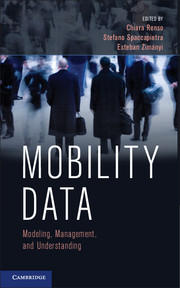Book contents
- Frontmatter
- Contents
- List of Contributors
- Preface
- Acknowledgments
- PART I MOBILITY DATA MODELING AND REPRESENTATION
- PART II MOBILITY DATA UNDERSTANDING
- 6 Mobility Data Mining
- 7 Understanding Human Mobility Using Mobility Data Mining
- 8 Visual Analytics of Movement: A Rich Palette of Techniques to Enable Understanding
- 9 Mobility Data and Privacy
- PART III MOBILITY APPLICATIONS
- PART IV FUTURE CHALLENGES AND CONCLUSIONS
- Bibliography
- Glossary
- Author Index
- Subject Index
- Plate section
7 - Understanding Human Mobility Using Mobility Data Mining
from PART II - MOBILITY DATA UNDERSTANDING
Published online by Cambridge University Press: 05 October 2013
- Frontmatter
- Contents
- List of Contributors
- Preface
- Acknowledgments
- PART I MOBILITY DATA MODELING AND REPRESENTATION
- PART II MOBILITY DATA UNDERSTANDING
- 6 Mobility Data Mining
- 7 Understanding Human Mobility Using Mobility Data Mining
- 8 Visual Analytics of Movement: A Rich Palette of Techniques to Enable Understanding
- 9 Mobility Data and Privacy
- PART III MOBILITY APPLICATIONS
- PART IV FUTURE CHALLENGES AND CONCLUSIONS
- Bibliography
- Glossary
- Author Index
- Subject Index
- Plate section
Summary
The Mobility Knowledge Discovery Process
We often say that “Knowledge is power” and this is particularly true in the mobility field, because mobility knowledge gives great power in terms of appropriate decision making to actors in several application files, ranging from traffic management to urban planning to ethology, just to give some examples. Mobility knowledge can be rephrased as how, when, where, and why objects move? For example, a traffic manager could improve traffic sustainability in a city when he or she discovers why a specific traffic congestion happens, or an ethologist could finally gain a deep understanding of why a given animal behaves in a given way.
The mobility data mining research field has seen a growing interest in the last few year – as already stated in Chapter 6 – providing several algorithms and techniques tailored on trajectory data. However, a common problem of these techniques is that the knowledge produced by the mining step is generally not really applicable to the application domain as it is. The lack of semantics of the extracted patterns makes the interpretation task far from obvious. This problem, commonly recognized in the data mining literature, is particularly significant in mobility data mining, where the complexity of the data themselves, together with the extreme multifariousness of the mobility application requirements, makes the knowledge discovery even more challenging. The interestingness evaluation of the discovered movement patterns makes sometimes the KDD process a mere academic application, useless in reality.
Information
- Type
- Chapter
- Information
- Mobility DataModeling, Management, and Understanding, pp. 127 - 148Publisher: Cambridge University PressPrint publication year: 2013
Accessibility standard: Unknown
Why this information is here
This section outlines the accessibility features of this content - including support for screen readers, full keyboard navigation and high-contrast display options. This may not be relevant for you.Accessibility Information
- 2
- Cited by
